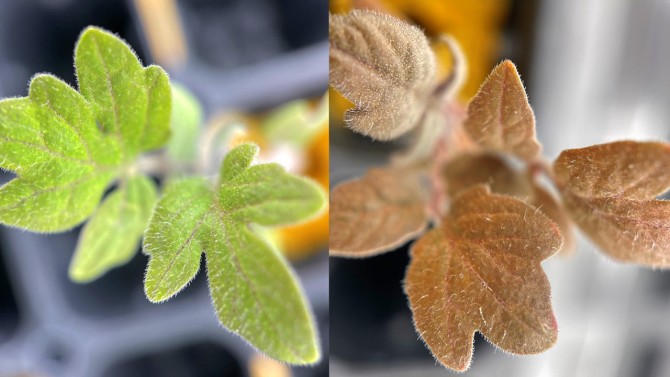
Cornell Students Develop Color-changing Tomato
October 8, 2025| |
Doctoral students Jacob Belding and Ava Forystek of Cornell University successfully developed genetically engineered tomato plants that turn vivid red when the soil nitrogen levels are low. Known as RedAlert Living Sensors, the modified plants are expected to help gardeners, farmers, and hydroponic growers become informed if their tomato plants need more nitrogen to grow.
Growers find out about their plant's nitrogen deficiency when the leaves wilt and turn yellow. However, this is considered late detection as the plants are already low in nutrients.
“We like to use the analogy of a dog that whines when it's hungry,” said Forystek. “It would be kind of ridiculous to wait until you feel its ribs to feed it.”
The engineered tomato plants use a native pathway in the plants responsible for nitrogen detection around the roots. Then, when the plant receives the signal, it transmits the signal to the rest of the plant. Thus, the tomato plants express a red pigment when the root zone nitrogen is low. Furthermore, varied shades of red also indicate the level of soil nitrogen.
“We're taking a signal from the roots where the plant first notices there's not enough nitrogen in the soil, and it translates that into visible pigment, so we can see on the plant that it is hungry for nitrogen, but it's not already starving,” said Belding.
RedAlert Living Sensors is one of the finalists in the Collegiate Inventors Competition organized by the National Inventors Hall of Fame.
Read more from Cornell Chronicle.
| |
You might also like:
- Protein Responsible for Strawberry’s Signature Red Color Identified
- Engineered Red Yeast Converts Forestry Waste into Valuable Fatty Acid
- High GABA Tomato Determined as Non-GM in the Philippines
Biotech Updates is a weekly newsletter of ISAAA, a not-for-profit organization. It is distributed for free to over 22,000 subscribers worldwide to inform them about the key developments in biosciences, especially in biotechnology. Your support will help us in our mission to feed the world with knowledge. You can help by donating as little as $10.
-
See more articles:
-
Plant
- Researchers Identify Soybean Gene that Could Help Crops Thrive in Acidic and Low-Phosphorus Soils
- Discovery of Wheat Pan-Transcriptome to Secure Global Food Supply
- Complete Genome Assembly Unlocks Potential of Northern Wild Rice
- Cornell Students Develop Color-changing Tomato
- Study Explores How GM Labeling Affects Purchasing Intentions
- Rothamsted Research Scientists Identify Key Wheat Genes that Control Plant Height and Grain Size
-
Animal
- MIT Genetically Engineers Mice to Stop Lyme Disease Transmission
-
Food
- FAO Calls for Building Safe, Sustainable, and Equitable Animal Feed Systems
-
Read the latest: - Biotech Updates (December 3, 2025)
- Gene Editing Supplement (November 26, 2025)
- Gene Drive Supplement (February 22, 2023)
-
Subscribe to BU: - Share
- Tweet

